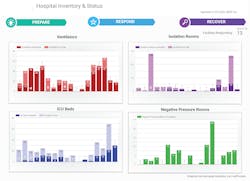During the pandemic some regions have experienced difficulty sharing real-time updates across health systems, skilled nursing facilities and public health. But in Riverside County, Calif., a 10-year-old healthcare emergency management coalition has been aided by a set of procedures and a common platform for sharing critical information.
The Riverside County Emergency Management Healthcare Coalition is made up of an array of providers, including 17 acute-care hospitals, clinics, 56 skilled nursing facilities, the county public health department, emergency management, and blood banks. They work together to plan, collaborate, share and analyze information; manage and share resources; and coordinate strategies to deliver medical care to all populations during emergencies.
That teamwork has proved to be extremely valuable during the pandemic, said Carolina Gonzalez, M.P.H., program coordinator for the coalition led by the Riverside County Emergency Management Department. One of the goals of the coalition is to help with medical surges, allowing provider organizations to deliver timely and efficient care to patients even when the demand for healthcare services at one facility exceeds available supplies.
The county currently has 490 people hospitalized with COVID and 153 in ICUs, according to the county public health website.
A key to the coalition’s capabilities, she said, is the fact that all members agreed to use the same technology platform, LiveProcess, which offers a secure, real-time virtual situation management system built for healthcare systems to dynamically rebalance business and clinical operations to meet demand while managing quality of care, employee and patient safety and financial risk.
“We ramped up in March,” Gonzalez said. “We already used LiveProcess for exercises and drills. Most of the hospitals already use it to call a code internally for staffing. Everybody is familiar it. We opened up an event in LiveProcess, and that is how we communicated with everybody as far as the level in our emergency operations center, updates from the hospitals, whether it was for PPE, what level they were surging at, reports, and resource requests.”
In the general message area of LiveProcess, health providers can update others in the coalition on their current status, she said. They also can create sidebar messages that include requests about needed equipment or personnel. Other hospitals can see that message and respond. "We have had instances in which a facility will offer staff or equipment to other providers in the same city or area,” Gonzalez said. “This makes it easier and facilitates that communication”
The coalition’s longer-term work has included creating partnerships between hospitals and skilled nursing facilities in drills and exercises. That also has come in handy as the hospitals already have close ties to the SNFs and could put that to use in helping them cope with COVID-positive patients as well as infection control, PPE and staffing shortages.
The coalition uses the LiveProcess platform whenever an emergency situation requires it, Gonzalez said. One of the notable ones was in May 2019 when an F-16 fighter jet crashed into a warehouse just outside the March Air Reserve Base in California, sending a dozen people to hospitals for evaluation after they were exposed to debris. The plane happened to fall into a building where medical and surgical supplies for the region were stored, Gonzalez said, “so not only did it impact the city, the base, but also our hospitals. LiveProcess was the epicenter of how we communicated with the hospitals, maintaining notice of what was housed in that warehouse they were running short on. We were able to provide that information to the neighboring counties as well and we were able to pull real-time data and supply it to our emergency services partners.”
The company LiveProcess is based in Chelmsford, Mass., and supports more than 500 U.S.-based healthcare organizations. In a blog post on its website, the company noted that some individual health systems use its platform internally as well as for regional emergency planning and communication. “For example, one early adopter of Live Process Aware is using it to innovate and automate the hospital’s stroke workflows. With anywhere from 40 to 70 staff members engaged in stroke patient care and services, there are multiple patient handoffs and repeated sharing of patient information. Meanwhile, a patient’s status can change at any point in the process, requiring an update to relevant staff members. Using Aware can reduce lag and save precious time by getting the most up-to-date information to the right people at the same time across departments, expediting the care delivery process.”


